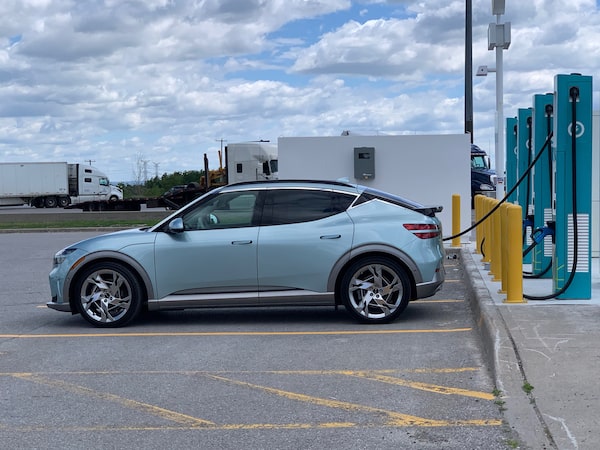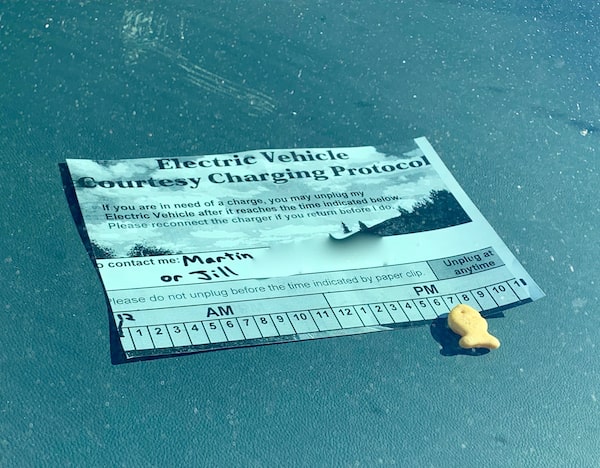
The Port Hope, Ont., OnRoute service area on Highway 401.Laurel Dixon/The Globe and Mail
As the wife of an automotive journalist, I’ve been a passenger in many electric cars. They’re not all happy memories. We used to make a weekly 150-kilometre round trip to visit my parents, and in early EV test cars I worried whether we’d make it because range was short and charging facilities scarce. On one winter trip, we turned off the heat to preserve charge.
Today, EVs have much more range and we’re considering buying one. Still, my main concern is having enough range to cover expeditions outside the Greater Toronto Area without recharging. I never paid much attention when my husband Jeremy Sinek plugged in an EV overnight, or while I sat quite comfortably at a public charging station, browsing my phone or reading a book.
Then last June, a Genesis GV60 Performance was offered as my ride for a women’s weekend away to Prince Edward County, about 2½ hours east of Toronto. The women attending were environmentalists eager to share this learning experience, but the idea of finding chargers and figuring out how to pay was causing me stress – the opposite of what I wanted for this trip.
With help, I downloaded charging-network apps and printed a list of charging stations (the car’s navigation system shows them, but nothing beats a hard copy).
When I picked up my friend on a Friday morning in Mississauga, she said the dash looked like something you’d see on a spaceship, with too many distracting features. But we soon agreed the car’s ride was smooth and comfortable.
It was about 225 kilometres to Wellington, Ont., well within the Genesis’s advertised 378-kilometre range, but my anxiety dictated a fast-charge top-up en route. A 30-minute session at the OnRoute highway rest stop in Port Hope, Ont., went quickly, paid for using the Ivy app. We had to use the facilities anyway, so the stop wasn’t inconvenient.
Two things did stand out: There were no picnic tables nearby to enjoy the beautiful weather, and apparently no garbage cans, as the area was full of litter.
Reaching Wellington ahead of schedule, we stopped to eat and to recharge again in readiness for our Saturday outings. The nearby Huff Estate winery had a fast charger, which we used free while we ate in their restaurant. When we were done, the car showed an 87-per-cent charge and 353 kilometres of range.
A few minutes’ drive brought us to our hostess’s driveway. I don’t know what I did wrong, but an overnight charge on a regular 110-volt outlet added only 1 per cent. Note to self: Don’t count on the overnight charge on Saturday to get back to Mississauga.
We spent Saturday driving around the area, taking in the sights, eating great food and visiting a market. The last stop was in Picton, Ont. While the rest of the group went to explore, I was happy to charge. Our hostess’s neighbour had told us she regularly uses a Level 3 ChargePoint station in town, but it didn’t work. A call to ChargePoint didn’t help. They apologized and tried a few times to reboot remotely, but without success. Now the car was showing 301 kilometres of range and we were 242 kilometres from home. That wasn’t enough of a cushion for anxious me.
We found a Level 2 charger at a local Ford dealership, but a car from Quebec was already plugged in. A note on its dashboard said we could unplug the car if it had reached a certain time. It was an hour before that time, but we called the number on the note anyway, and Martin on the other end said we could unplug his car.

An EV driver used a Goldfish snack to indicate when the car could be unplugged from the public charger.Laurel Dixon/The Globe and Mail
But when I plugged in the Genesis, the charger predicted a charging time of eight hours. We didn’t have that kind of time. After about 20 minutes, we reconnected Martin’s car, drove back to our hostess’s house and plugged into the 110-volt outlet.
The next morning we had a 75-per-cent charge and 324 kilometres of range. Plenty to get home for most … but not me.
We stopped at a Petro-Canada station just off the 401 in Cobourg, Ont. Payment was by credit card. The two chargers were unoccupied until a woman from Montreal arrived and confidently plugged in. You could tell she had done this many times before. Except, her charger didn’t work. “That’s too bad,” I thought, while feeling grateful I’d picked the other charger.
Then she told us that charging beyond 80 per cent is very slow and isn’t good for the battery. That was news to me. I wasn’t yet at 80 per cent, so no pressure. Meanwhile, she called Petro-Canada and requested a reboot. That did the trick.
As she charged, she shared another nugget of wisdom: Even if a fast charger has two plugs, it can only charge one vehicle at a time. She said loved her electric car and her husband had one too. I began to feel like I was in a club. Two days of EV driving and I think I was hooked.
We arrived home with lots of charge to spare – the way I like it. We’d had a great weekend away. The EV hadn’t detracted from the experience, and between the paid fast-charging and some free plug-ins, we’d spent less than $20 on “fuel.”
Passenger Judy felt that once you stray from Highway 401, the infrastructure doesn’t yet support a road trip in an EV. She said she will buy one for driving around the GTA, but keep a gas-powered car for longer trips.
I surprised myself that I could handle an EV with the charging, apps and calling the help lines if needed. If I bought an EV now, I’d probably remain overcautious at first, but over time would learn to gauge distances and charging times. After all, I don’t always check my gas gauge when I leave home.